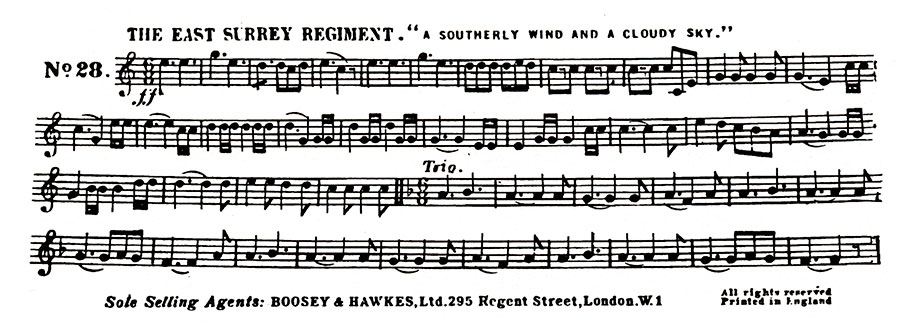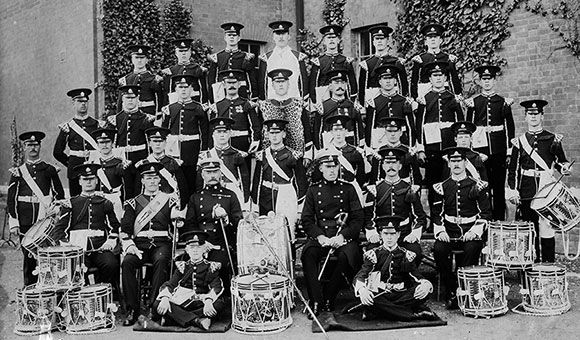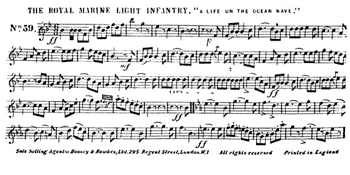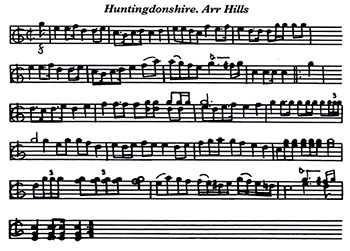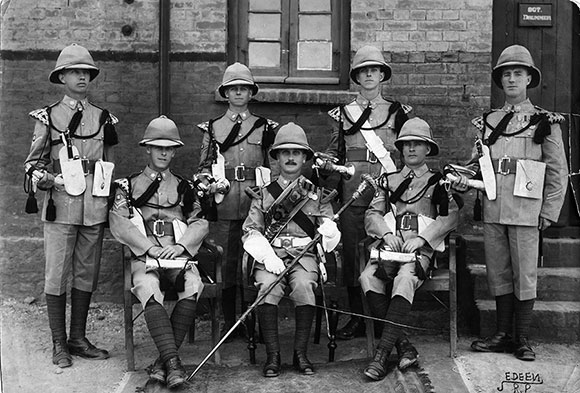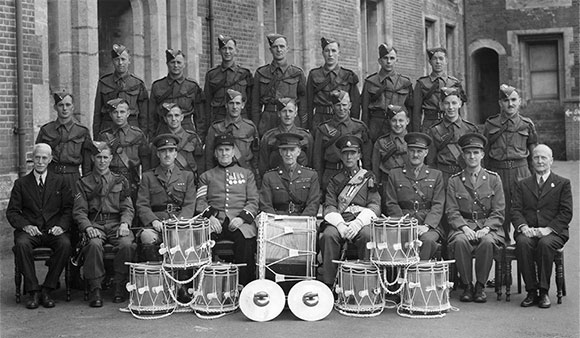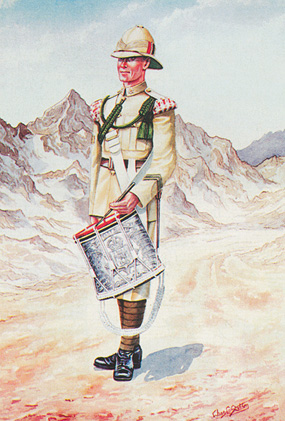 Band and Drums Music
Band and Drums Music
The East Surrey Regiment
The 31st (Huntingdonshire) Regiment of Foot was raised originally as Villiers Marines in 1702. They were recruited from Taunton and Bridgewater. The 70th (Surrey) Regiment was raised in Glasgow in 1756. In 1881 they became the 1st and 2nd Battalions of The East Surrey Regiment.
A Southerly Wind and a Cloudy Sky
(Click to enlarge)
Quick Marches
'A Southerly Wind and a Cloudy Sky'
The Regimental Quick March of The East Surrey Regiment. All that is known of the old 1st Battalions march, is that it was derived from an old hunting song. The origin of the tune itself is unknown, and there is no record of when it was adopted by the Regiment, whether the march was associated with the Thirty First Regiment, or whether it was first heard as the march of the 1st Battalion The East Surrey Regiment, after amalgamation in 1881. It would probably be unwise to draw any conclusions from the facts that the march came from an old hunting song and that there was a huntsman in the badge of the Thirty First (Huntingdonshire) Regiment.
'A southerly wind and a cloudy sky
proclaims a hunting morning
Before the sun rises we nimbly fly
Dull sleep and downy bed scorning.
To horse my boys, to horse away
The chase admits of no delay;
On horseback we've got, together we'll trot,
On horseback we've got, together we'll trot.
'The Lass O'Gowrie'
The Regimental Quick March of the 70th Regiment of Foot, a Regiment which in 1881 became the 2nd Battalion The East Surrey Regiment. The song was founded on an older ballad by William Reid of Glasgow, called 'Kate O'Gowrie'. The melody was known as 'Loch Eroch Side' and was taken from 'O'er Young to Marry Yet' in 1757. The actual song, 'The Lass O'Gowrie' was written by the once famous poetess and songwriter, Lady Carolina Nairne.
The Lass O'Gowrie
(Click to enlarge)
The 70th Regiment was raised in Glasgow in 1756 and was stationed there until 1759. During this period they were known as the 'Glasgow Grey's' from their grey facings. Carolina Oliphant later Lady Nairne, was born in Scotland in 1766. She wrote a number of songs from an early age. If we assume she was about 24 when 'Lass O'Gowrie' was written, that would bring the date to around 1790.
Regimental history does not record when the 70th adopted 'Lass O'Gowrie' as the Regimental March, but if the assumption above is more or less correct, the date would not have been before 1790. When considering the music for the Regimental quick step, it was appropriate that the 70th should select a Scottish song associated with their early days in Glasgow. It is possible that 'Lass O'Gowrie' was chosen as the march of the 70th Regiment of Foot, there being a geographical connection by way of Gowrie being an area of Perthshire. Whether 'the lass' was real or figment is open to question.
'Twas on a summer's afternoon
A wee before the sun gaed down
My lassie, wi' a braw new gown
Cam' owre the hills to Gowrie
The rosebud tinged wi ' morning show 'r
Blooms fresh within the sunny bow'r;
But Katie was the fairest flow 'r
That ever bloom 'd in Gowrie
I prais 'd her beauty loud an' lang
Then round her waist my arms I flang
An'said,
My dearie,
Will ye gang to see the Charse O'Gowrie?
The Corps of Drums, 1st Bn The East Surrey Regiment. Plymouth 1910
(Click to enlarge)
'A Life on the Ocean Wave'
The Regimental Quick March of the Royal Marines. The East Surrey Regiment had a long and historic association with the Royal Marines, and to give expression to all of these strong connections between the two a custom was instituted some years ago of each playing the other's Regimental March on ceremonial occasions.
A Life on the Ocean Wave
(Click to enlarge)
As 'Villiers Marines' the 1st Battalion was raised in 1702 for the War of the Spanish Succession. It did not become a Foot Regiment until 1715. In 1825 when the Regiment was sailing to India, a portion of it was shipwrecked in the Bay of Biscay when the East Indiaman 'Kent' took fIre, and the survivors were taken back to Chatham where the Royal Marines looked after their welfare. In memory of this episode the Royal Marines and the 31st Foot made each other honorary members of their messes. The 1st Battalion followed the Royal Marines custom by saying Naval Grace seated before dinner in the OffIcers Mess. This custom continues to this day. General Sir Richard Foster of the Royal Marines was Colonel of The East Surrey Regiment from 1939 to 1946.
The Officers, Regimental Sergeant Major and Bandmaster of the 1st Battalion The Queen's Royal Surrey Regiment were permitted to wear the Royal Marine Lanyard, a tradition inherited from The East Surrey Regiment. This tradition was continued on the formation of The Queen's Regiment in 1966 in the 1st Battalion only, and later in The Princess of Wales's Royal Regiment.
Slow Marches
Lord Charles Montague's 'The Huntingdonshire March'
The Regimental Slow March of The East Surrey Regiment.
From 1792 to 1881 the 1st Battalion was known as the 31st (Huntingdonshire) Regiment. It was during this period, the Regiment adopted 'Lord Charles Montague's Huntingdonshire March'.
Despite research by many officers over the years the background of 'Lord Charles Montague's Huntingdonshire March' remains obscure. It is still used today by The Princess of Wales's Royal Regiment, particularly on Sobraon Day when the Regimental Colour is entrusted to the Sergeants' Mess. A sergeant selected by the Regimental Sergeant Major receives the Colour from the Commanding Officer and, together with the Colour Party, preceded by the Band End Drums, if a Band is available, if not preceded by the Corps of Drums, the Colour is marched through the ranks of the Battalion which line the route from the Officers' Mess to the Sergeants' Mess where they halt. The march 'The Huntingdonshire March' is played and the Sobraon Sergeant slow marches into the Mess with the Colour, where it remains until the conclusion of the Sobraon Day Dinner.
The Huntingdonshire March
(Click to enlarge)
2nd Bn The East Surrey Regiment, Gibraltar 1927-1929.
Drum Major and Drum's NCOs, Drum Sergeant J French.
(Click to enlarge)
The 2nd Battalion The East Surrey Regiment suffered very heavy casualties during the Japanese advance in Malaya in 1942. The 1st Battalion The Lestershire Regiment suffered a similar fate. As a result the two battalions were amalgamated to form The British Battalion. When the British surrendered, the British Battalion spent the rest of the war as POWs of the Japanese.
The 10th Battalion of The East Surrey Regiment was renamed the 2nd.
(Click to enlarge)
Drummer, 1st Battalion The East Surrey Regiment 1926
(Click to enlarge)
Related
